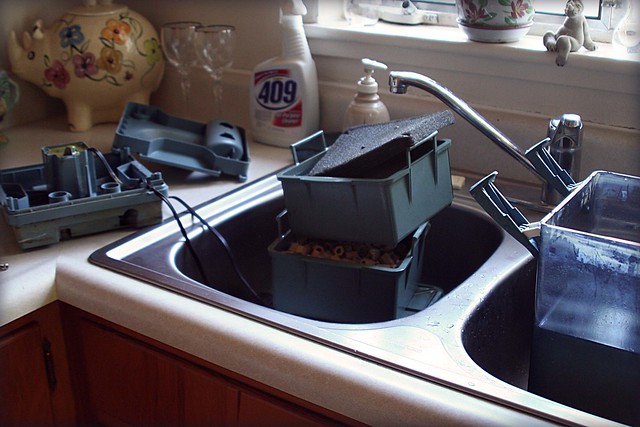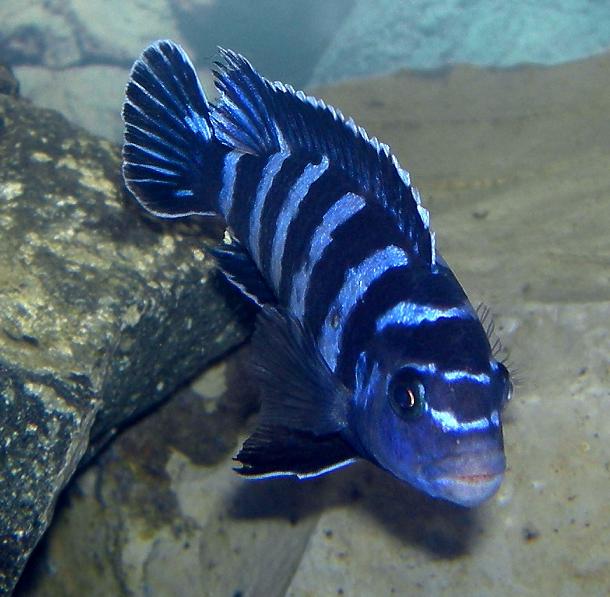Having a good aquarium filter can make the difference between enjoying fish-keeping or not. Here are descriptions of the different kinds of aquarium filters available, what kind of tanks they are best for, and the overall pros and cons of each option.
 |
| My Afternoon - Photo by armigeress |
Corner filters
These small clear plastic box filters have an airstone that pushes water up through layers of floss and charcoal. The box sits in the gravel in a corner of the tank. Sometimes they need to be weighted down to keep them from floating. They are very cheap, but not terribly efficient. While they do add some aeration to a tank, you are not going to clean up a dirty tank with this kind of filter.
Sponge filters
These are similar to corner filter, but there is no floss or charcoal or even a plastic box -- all filtering is done through a sponge. Again, this is not a very efficient filter, but it does help. Sponge filters are used in fry and quarantine tanks because they create no strong currents, and they do clean up a tank a bit, and they provide some aeration. Fry may also enjoy nibbling algae off the sponge.
Undergravel filters
Undergravel may be the best choice for a standard community tank. You can also combine an undergravel filter with an exterior box filter for some extra clean water. The benefits are that undergravel filters are relatively cheap, they do a good job once they are established, and they do not create strong currents that some fish, like bettas or discus, will not like. These filters use biological and mechanical filtration by pulling the dirty water in the tank down through the gravel. The plastic aisles of the undergravel filter hold the gravel up so there is a small space at the bottom of the tank. This is where most of the debris is captured. The clean water is pushed up through two tubes on either side of the back of the aquarium and pushes the clean water out -- fairly gently -- through two window-shaped grates.
Undergravel filters use your aquarium's gravel as the filtration media. While there is mechanical filtration, most of the action is happening via biological filtration in the gravel. So these filters may take a few days to show you clean water. There's also no way to upgrade them aside from adding a powerhead, which is only going to add more pull. You will also need an air pump to run an undergravel filter. The stronger it is, the more filtration you will get.
External/hang on the side filters
These filters are boxes that do most of their work just outside of the tank. They hang on the side with an uptake tube that goes down into the tank. The dirty water is pulled up the intake tube and pushed through a series of sponges and usually a bag of activated carbon. This performs biological, mechanical and chemical filtration. The clean water is pushed out through a trough formation that spills into the tank.
These kinds of filters do create a bit of current, especially if you have got a large tank. They can handle tanks up to 100 gallons, and if you had a larger tank than that (lucky you) you could just add a second filter. These kinds of filters have to be cleaned about every week to two weeks by squeezing out the sponges until all the trapped particles are released. Sometimes small fish get caught or pulled up by the intake tube, but this only happens with very, very small fish. That said, do not use these kinds of filters in a fry tank. Otherwise, they do a pretty good job and are a very good filter for the money. They run about $20 for a 20-gallon tank. "Trickle" filters are similar technology.
Canister filters
These are the "big dogs" of the filter world. Unless you have a community tank that is over 50 gallons, using a canister filter is a bit like swatting a fly with a cannonball. The benefit to canister filters is that they do a very, very good job and you do not have to clean them more than once a month if that.
Some people "cheat" and buy canister filters made for tanks two or three or even four times the size of their aquarium and then (sometimes) they can get away with cleaning the filter less than once a year. If you have lots of extra money, but very little extra time, this is a viable trick for those of us who hate cleaning the fish tank (you still have to do water changes, though). The downside is that cleaning canister filters is a big deal and they are quite expensive ($75 to $300).
Article Directory: EzineArticles |






